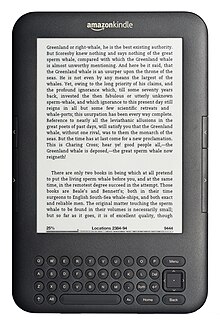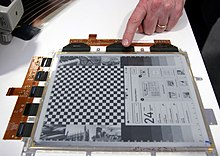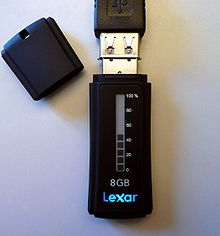Electronic paper
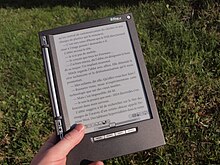
As Electronic paper (short e-paper or English e-paper , e-paper or ePaper called) are called display techniques that are used to trying the look of ink and color on paper replicate.
E-paper displays reflect the light like normal paper, so they are passive (non-luminous) displays. Based on the English usage, such screens are also referred to as reflective displays. With some display technologies, texts or images are displayed permanently without the need for a float voltage. However, the display can be changed at a later date. With some manufacturers, electronic paper is flexible - similar to normal paper.
Although there are various processes for producing electronic paper and a large number of companies are now researching and developing them, the term e-ink is often used as a synonym for electronic paper. Strictly speaking, E Ink (proper spelling without the hyphen) is just the brand name of the E Ink Corporation product that is currently used in most modern e-book readers and that is based on the phenomenon of electrophoresis .
technology
Gyricon
In the 1970s, researcher Nick Sheridon at Xerox's Palo Alto Research Center was the first to develop electronic paper. It was called a gyricon and consisted of small, statically charged spheres. These were two-colored: black on one side and white on the other. The text content of the paper could be changed by an applied electric field . This rotated the beads up or down so that either the black or white side was visible.
Gyricon could not be produced inexpensively enough, so that Xerox dissolved the company Gyricon LLC, which was founded for marketing purposes, at the end of 2005.
Electrophoresis
precursor
In the 1990s, a team led by Joseph Jacobson at MIT used small microcapsules in which electrically charged white particles floated in colored oil. Due to the polarity of an applied electric field, the white particles migrate either to the top of the microcapsule (i.e. visible to the viewer) or to the bottom, so that the viewer saw the darker color of the oil at this point. The American company E Ink Corporation developed its current electronic paper on the basis of this technique, which is based on electrophoresis .
construction
This electronic paper contains microcapsules with an average diameter of approx. 40 µm, which contain positively charged white particles and negatively charged black particles in a transparent, viscous polymer . The display is changed by briefly applying an electrical voltage and then remains stable for several weeks. The shape and diameter of the microcapsules are irregular, but this is insignificant, since each individual pixel is composed of many microcapsules and these irregularities are thus averaged out.

The use of microcapsules also allows flexible plastic to be used as the carrier material instead of glass.
In segment displays, the pixels are controlled by means of passive transparent electrodes and in matrix displays via a TFT active matrix , as is also used in LC screens .
The display of gray levels is controlled by the time profile of the applied voltage. Originally eight shades of gray could be displayed, the current displays work with 16 shades of gray. In conjunction with raster processes known from printing technology and image processing , a seemingly continuous gray value display is achieved.
colour
Color displays are either based on black and white electronic paper with upstream color filters, or they are equipped with colored pigments.
Manufacturer
The E Ink Corporation has introduced since 1999 various applications and the first manufacturer to start serial production electronic paper larger scale of 2004. Other manufacturers' products were or are, for example, "SiPix Microcup®" the American company Sipix (which has been taken over by the E Ink Corporation in 2012), the flexible electronic paper "Lectum" of the manufacturer Plastic Logic , which by mid-2019 in Dresden was made , the flexible e-ink displays from LG Display or the “O-paper” from the Chinese manufacturer Guangzhou OED Technologies . Another manufacturer of electrophoretic electronic paper with its own technology was Bridgestone , whose development was discontinued in 2012.
Since 2002, companies such as E Ink , Bridgestone or Philips have presented various prototypes of colored electrophoretic e-paper, none of which have gone into series production. In 2011, E Ink Corporation started production of “Triton” electronic paper using color filters, and in 2016 the company introduced “ACeP”, which uses colored pigments.
Carrier material
Flexible electronic paper is mainly used in industrial displays and in advertising. In electronic reading devices, which are preferably designed for the best possible contrast and long service life, glass displays dominate, even if prototypes with flexible screens are shown occasionally, such as the foldable e-ink display.
lighting
Since e-ink displays are not translucent, the screens cannot be backlit. For this reason, LEDs are installed on the edge of the display, the light of which is distributed through a diffusion layer or a light guide film in front of the display. The light guide film is provided with microstructures that couple the light predominantly in the direction of the e-ink display. This type of display lighting is in English Front Light called what either directly as a front light translated or as a front light is called.
Electrophoretically controlled total reflection
At SID Display Week 2017 , the US company CLEARInk presented displays that are based on the combination of a film with totally reflective lenses and a layer of electrically charged particles behind it in a liquid. The particles are moved by an applied electric field, and when they attach to the rear surface of the lens, total internal reflection is suppressed by absorption.
This technology can be used to produce displays that are fast enough for video playback, and bistable displays that reflect significantly more light than is possible with e-ink displays should be possible.
Bistable LCD
Some companies produce electronic paper based on bistable LCDs. These enable a neutral white with high albedo (surface reflection) and resolutions up to 200 dpi. One example is the Cholesteric Liquid Crystal Display .
Electrowetting
The Philips company offshoot Liquavista has developed a display technology in which a colored oil and a water layer are superimposed. The light permeability of the individual pixels is influenced by changing the surface tension by means of applied electrical voltage ( electrowetting ). Colored and fast reflective displays with high contrast and low energy consumption can thus be produced, the switching speed of which also allows video playback.
The functional prototype of an e-book reader with a colored 6 ″ electrowetting display was presented at CES 2010.
Liquavista was taken over by Samsung in early 2011 and by Amazon in early 2013.
Liquavista was closed in 2018. A new company called Etulipa is trying to establish the technology for billboards.
Micromechanically controlled interference modulation
The mobile radio technology manufacturer Qualcomm produced IMOD displays sold under the name “Mirasol” . These were based on the fact that the distance between two reflective layers was micromechanically changed and the light reflection was controlled by means of constructive and destructive interference . The display elements are bistable (as with e-ink) and enable the production of energy-saving reflective displays. Qualcomm presented functional prototypes of 5.7 ″ readers with colored Mirasol displays at CES 2010, which are also suitable for video playback. The start of production on a larger scale was originally announced for 2012, but there were only a few products. One of these was the Kyobo reader, which was sold in Korea.
Thereafter, work was carried out on a new generation of Mirasol displays called SMI (Single Mirror IMOD), in which the individual pixels could be tuned across the spectrum and therefore color filters were no longer required. This technique has no longer been used in end products, as Mirasol development was discontinued in 2015 due to ongoing financial losses.
Advantages and disadvantages compared to conventional screens and paper
Electronic paper combines the advantages of a computer screen and paper. Compared to conventional screens such as those used for TV and graphics display, it offers the following advantages at the current level of development:
- Due to the small distance between the imaging elements and the surface, the image content looks the same from every angle (advantage over LCDs ).
- There is no flickering due to the static display (advantage over tube monitors ).
- It is very thin and light and, with the appropriate design, also flexible.
- It can be produced in all sizes and shapes - from a small display with the current weather forecast to a large display board or billboard.
- It uses very little energy to create and maintain the display, as a current flow is only required to change the image content (page change).
- It can be read in normal room light as well as in bright sunshine, since the imaging elements are reflective.
The disadvantages compared to print media such as paper are the rather smooth surface of the display cover, which reflects stray and stray light. Both the gray value resolution (currently only 16 gray levels) and the contrast are still low, and white areas reach a light light gray in the best case. The long switching times of the first generation of electronic paper only allow a static display. The color space of the colored displays is comparatively limited. The energy-saving mechanisms of the e-book reader can also cause ghosting effects .
Applications
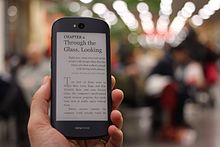
As a first field test to deliver a newspaper, the Belgian business newspaper De Tijd carried out a test with two hundred readers from April to June 2006. The device used was the iRex iLiad .
A field test with electronic paper as advertising space was carried out by Hitachi in late 2006 . In local trains on a Tokyo railway line, displays based on electronic paper from Bridgestone were installed to replace ordinary advertising posters. Opinion polls should then decide on the marketability.
There are now many devices in which e-paper displays are used:
- Numerous manufacturers produce reading devices for electronic books or sell them as OEM devices with their own firmware. This is the main use of electronic paper at the moment.
- The Motofone F3, manufactured by Motorola , was the first mobile phone to have built-in electronic paper for displaying. Motorola referred to this display as "EPD", it is a segment display with electronic paper from E Ink. The unusual effect compared to other display methods is that the display is retained when the battery is removed from the mobile phone. One advantage over other telephone displays is that the display remains legible even in direct sunlight.
- Lexar has manufactured the JumpDrive Secure II Plus, Echo MX and M10 USB sticks that show the level of their memory on a display using electronic paper. Since the display content is retained without a power supply, these devices do not require a battery.
- Western Digital has been selling external hard drives since August 2009 (My Book Elite and My Book Studio series) that have a so-called E-label on their front. The E-label shows a freely selectable line of text (content of the hard drive), the available free space and the activation of the drive encryption.
- In 2005, the Seiko company launched the "Seiko Spectrum" model, the first wristwatch to be equipped with an e-ink segment display.
In 2010 the first e-ink watch with a matrix display appeared. The display has 80,000 pixels with a resolution of 300 ppi. Each pixel can display one of four shades of gray. - The Austrian department store chain Billa uses e-ink displays as price tags , so the sales prices of certain goods can be changed from the office. The Swiss Migros is also increasingly relying on electronic price tags, and Lidl announced in 2019 that it will be using digital price tags in Switzerland in the future.
Other uses
- Esquire magazine was published on September 8, 2008 on the occasion of the 75th anniversary as the first magazine with a cover that was equipped with electronic paper. The e-ink insert used was not a matrix display, but was used to switch headlines on and off, invert them and make text areas flash. The "Special Collector's Edition" was produced 100,000 times.
- Increasingly, e-paper displays are also used for door signs, e.g. B. used in conference rooms with frequently changing use, or in supermarkets to mark prices on the shelves.
See also
Web links
- Prachi Patel: Video-compatible e-paper (" Technology Review ", German edition, April 29, 2009)
swell
- ↑ SHIN Kwang Hoon: "Flexible Display". In: Patent Application Full Text and Image Database. US Patent & Trademark Office, December 22, 2006, accessed August 15, 2007 .
- ↑ Chau Tu: How Electronic Ink Was Invented. The screen technology used in e-readers like the Amazon Kindle was conceived by undergraduates at MIT. In: Science Friday. May 10, 2016, accessed on September 2, 2017 .
- ↑ MIT Media Lab : Joseph M. Jacobson
- ^ E Ink Corporation
- ↑ plasticlogic.com
- ↑ saechsische.de Plastic Logic factory closed
- ↑ lgblog.de ( Memento of the original from December 4, 2011 in the Internet Archive ) Info: The archive link was inserted automatically and has not yet been checked. Please check the original and archive link according to the instructions and then remove this notice. : Flexible e-ink displays from LG
- ^ Guangzhou OED Technologies
- ↑ Ulrike Kuhlmann: Powder display now also flexible. In: Heise online . October 29, 2009 . Retrieved August 19, 2017.
- ↑ Ulrike Kuhlmann: Bridgestone: No future for e-paper displays. In: Heise online . May 18, 2012 . Retrieved August 19, 2017.
- ↑ Jürgen Rink: E-Ink presents the first color e-paper. In: Heise online . July 2, 2002 . Retrieved September 2, 2017.
- ↑ newgadgets.de : Colored E-Ink in Japan
- ↑ read.net : Bridgestone Aerobee E-Paper demonstrated
- ↑ Ulrike Kuhlmann: Flexible colored e-paper from LG.Philips. In: Heise online . May 14, 2007 . Retrieved September 2, 2017.
- ↑ einkgroup.com : E Ink announces advanced color epaper
- ↑ ebook-reader-vergleich.de : E Ink introduces foldable eReader
- ^ Röhm GmbH : Thin, thinner, light guide film
- ↑ c't 01/2013, p. 72 : A light goes on - e-book reader with reader-friendly displays and LED light
- ↑ heise online : Amazon's new Kindle now has a front light
- ↑ Pocketbook : User Manual Inkpad 3
- ↑ businessinsider.com CLEARink Wins Best In Show Award At DisplayWeek 2017
- ↑ clearinkdisplays.com Description of the CLEARink technology
- ↑ Youtube video interview with the CLEARink CEO
- ↑ chemie.de development agreement between Merck and ClearInk
- ↑ Liquavista: ( Page no longer available , search in web archives ) Info: The link was automatically marked as defective. Please check the link according to the instructions and then remove this notice. Technology whitepaper
- ↑ read.net Liquavista shows colorful e-papers
- ↑ Liquavista press release ( Memento of the original dated May 11, 2011 in the Internet Archive ) Info: The archive link was inserted automatically and has not yet been checked. Please check the original and archive link according to the instructions and then remove this notice. Liquavista gets acquired by Samsung
- ↑ Golem Amazon buys display manufacturer for color Kindle
- ↑ Good E-Reader Amazon has Shut Down Liquavista Offices in the Netherlands
- ↑ everything @ book Liquavista website is offline - what's next?
- ↑ slashgear.com Qualcomm mirasol color ereader hands-on
- ↑ Florian Müssig: Qualcomm shows a colored Mirasol display. In: Heise online . January 10, 2010 . Retrieved September 2, 2017.
- ↑ Roland Quandt: Mirasol displays come (still) later. In: Mobilegeeks. New Media Publishing & Consulting Ltd., June 4, 2011, accessed September 2, 2017 .
- ^ Qualcomm Mirasol Mirasol Technology
- ↑ Good E-Reader The Rise and Fall of Qualcomm Mirasol e-Readers
- ↑ Ulrike Kuhlmann: Display Week: Color E-Paper Monitor. In: Heise online . June 7, 2014 . Retrieved November 24, 2014.
- ↑ IBBT ( Memento of the original from August 20, 2007 in the Internet Archive ) Info: The archive link was inserted automatically and has not yet been checked. Please check the original and archive link according to the instructions and then remove this notice. Presentation of the results of the field test
- ↑ Martin Kölling: The display of the future in a field test. In: Heise online . December 15, 2006 . Retrieved November 24, 2014.
- ↑ engadget.com: Engadget article on the Seiko Spectrum
- ↑ Seiko.de : Seiko presents the world's first EPD watch with an active matrix system
- ↑ futurezone e-ink technology conquers supermarket price tags
- ↑ Urs Helbling: First electronic price tags in Aargau: How Migros spices up its “Igelweid”. In: aargauerzeitung.ch . January 18, 2020, accessed January 18, 2020 .
- ↑ Bastian Heiniger: This is how Aldi and Lidl put Migros under pressure. In: handelszeitung.ch . March 18, 2019, accessed March 18, 2019 .
- ↑ Demonstration video of what the Esquire's e-ink cover looks like
